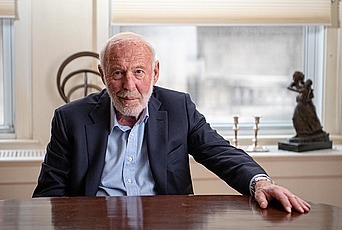
Remembering the Life and Careers of Jim Simons
Jim Simons, former IAS Member (1972), Trustee (2001–18), and Board Vice Chair (2010–18), "led a life driven by curiosity." A tribute posted on the Simons Foundation website, summarized here, honors his achievements in mathematics, business, and philanthropy.
From childhood, Simons showed an affinity for mathematics. He earned his undergraduate and doctoral degrees in the subject from the Massachusetts Institute of Technology and University of California, Berkeley in 1958 and 1961 respectively. Having completed his doctorate, Simons briefly taught at MIT and Harvard University before joining the Institute for Defense Analyses in Princeton, New Jersey. Following a stint as a code breaker for the National Security Agency, he became the head of the mathematics department at the fledgling Stony Brook University, during which time he also joined the Institute for Advanced Study as a Member (1972) in the School of Mathematics.
While at Stony Brook, Simons notably collaborated with Shiing-Shen Chern, a frequent past Member in the School of Mathematics. "Together, Simons and Chern published a paper in 1974 titled 'Characteristic Forms and Geometric Invariants' that introduced geometric measurements called Chern-Simons invariants. Though the pair didn’t know it at the time, their work would play a seminal role not only in mathematics but in quantum field theory, string theory, and condensed matter physics. In 1976, Simons received the American Mathematical Society’s Oswald Veblen Prize in Geometry for his mathematical research, including the discovery of Chern-Simons invariants."
In 1978, Simons left academia to start what would become Renaissance Technologies in a strip mall around the corner from Stony Brook. "After some false starts, the business quickly found a highly profitable approach." In 1994, he founded the Simons Foundation alongside his wife Marilyn Simons, with the aim of advancing the frontiers of research in mathematics and the basic sciences through grant funding, support for research, and public engagement. Countless IAS scholars have benefitted, and continue to benefit, from Simons Foundation funding.
"During a 2010 talk at MIT, Simons set forth the five guiding principles that had shaped his life and careers in mathematics, investing, and philanthropy. 'Do something new; don’t run with the pack. Surround yourself with the smartest people you can find. Be guided by beauty. Don’t give up easily. Hope for good luck!'"
Read the full tribute on the Simons Foundation website.
Other tributes to Simons have appeared in the New York Times and Financial Times.


